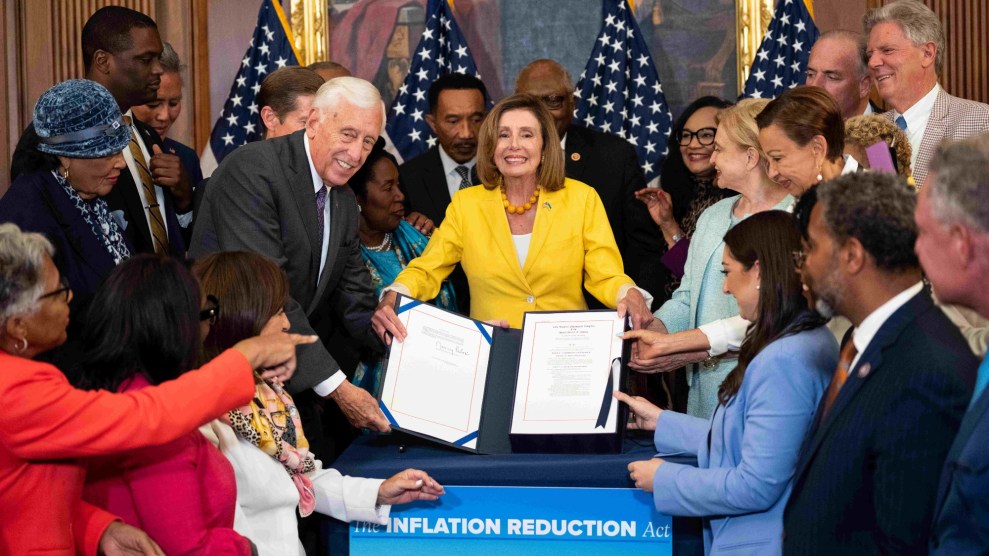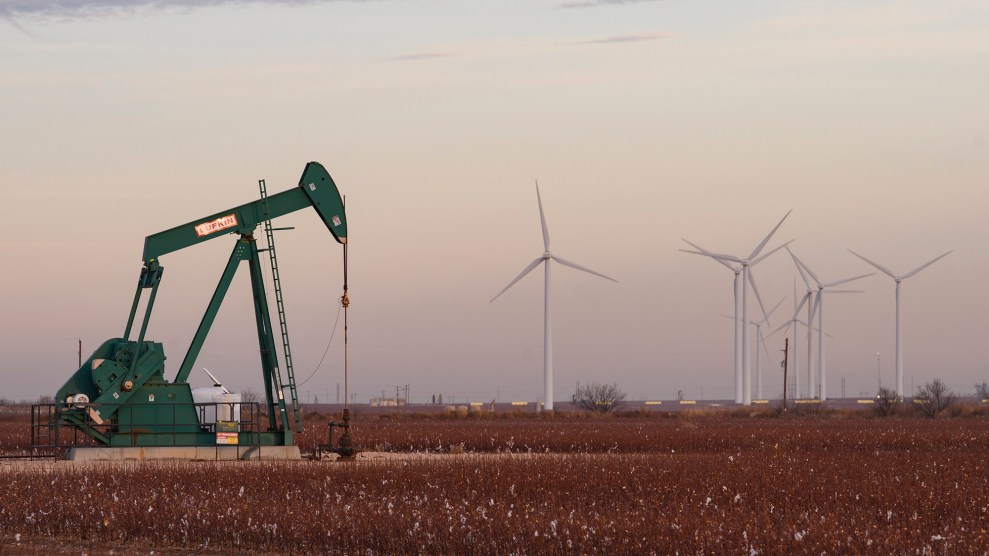
House Democrats celebrate passage of the Inflation Reduction Act.Bill Clark/ZUMA Press
This story was originally published by Slate and is reproduced here as part of the Climate Desk collaboration.
Americans feeling the heat of climate change will find a lot to like in the Inflation Reduction Act—and a decent bit to criticize. Overall, the climate movement has cheered the bill’s $370 billion climate investment, albeit with reservations about some of its fossil-fuel tradeoffs. My colleague Jordan Weissmann recently addressed some of the more prominent complaints: that the bill requires federal lands and offshore waters utilized for renewable energy development to also be opened up for oil and gas drilling, and that the deal reached with Sen. Joe Manchin included future concessions that could greenlight a West Virginia gas pipeline and ease the process for permitting new energy projects.
Add to all that nitpicks like the IRA’s subsidy of arguable climate solutions like “clean” hydrogen, carbon capture and storage, biofuels, and big electric automobiles to the exclusion of non-car EVs. It’s a lot of buts.
As always, two things can be true: The IRA is an unprecedented and necessary climate bill that will reduce emissions to a significant degree, and it has some flaws. It was never going to be any other way—Democrats’ narrow hold on the Senate, the influence of big business, a hostile judiciary, and Americans’ extreme sensitivity to gas prices meant there would have to be compromises on any climate package. Yet even with these snags, many analyses of the bill have determined it to be a net good.
The think tank Energy Innovation calculates that for every ton of carbon emissions from new oil and gas, there will be 24 tons reduced due to measures governing buildings’ energy use, home electrification, and green lands set aside as carbon sinks. So with the IRA now making its way to President Joe Biden’s desk, it’s worth taking stock of just how much of a boon it will be to fossil fuels.
Let’s start with the IRA’s mandate to tie renewable development on federal lands and waters to auctions on millions of acres to fossil fuel drillers. Oil historian Gregory Brew doesn’t think this is as apocalyptic as some have made it out to be. “Investment in new offshore projects has been declining over the last five years,” he told me in a message, “and recent lease sales have generated only tepid interest.”
Notably, even when the Biden administration has held such auctions, like in the Arctic National Wildlife Refuge or the Gulf of Mexico, oil firms have not always taken them up. The Bureau of Land Management’s own statistics consistently show that when government-owned acres are put up for auction, only a small portion of that land is purchased. Brew also pointed out that offshore fossil fuel development is expensive, even without the additional fees on the practice in the bill. (There’s also now competition from increasingly subsidized offshore wind.)
The Center for Biological Diversity, an environmental nonprofit and leading critic of the IRA, takes a more pessimistic view, noting that the hundreds of millions acres for drilling locked into the bill far exceed the average leased acres auctioned off in a given year. The sheer scope on offer to fossil-fuel producers is what concerns the group: “This is a devil’s bargain that handcuffs even one offshore wind project to offering up 60 million acres of federal waters for offshore drilling—that’s the area of four West Virginias every year for a decade.”
So it’s an open question of just how much fossil-fuel activity will occur on federal land as a result of the IRA, but the outcome probably won’t be a massive land grab. Both on- and offshore, there are fewer bids on federal leases than before, and still less actual activity on those leased acres—and that’s before the increased royalty charges of the IRA come into play. As research firm Rhodium Group noted in its preliminary assessment of the IRA, “only a fraction of public land acreage put up for sale actually gets purchased, and only a fraction of sold leases actually get developed.”
Meanwhile, the bill pushes back against the very fossil-fuel activities it permits. The bill’s mechanisms to discourage harmful exploration practices for oil and gas include fees for natural gas extraction and methane leaks, and Superfund taxes on crude oil and its related products. (Oil corporations do get some bonus cash should they actually reduce their methane.) These measures are intended to raise revenue, but they also act as disincentives for fossil fuel businesses; see the bill’s new tax on the sorts of stock buybacks many oil companies have recently pocketed for themselves. The IRA also appears to take enforcement seriously, gifting additional resources to the IRS, allocating tens of millions of dollars toward methane and air pollution monitoring, and granting the EPA to charge energy companies for methane damages.
The Center for Biological Diversity see these taxes as not going far enough. Regarding the methane fee, “It will only apply to very large emissions sources that have to comply with the EPA oil and gas regulation,” the center wrote to me in an email. “Any emissions that don’t fall under that regulation are exempt from the fee.” The nonprofit also isn’t convinced that a hiked federal royalty rate for lease sales will be all that effective considering that some key oil states have higher local fees for state-land leases: “If production is booming with a 25% fee in Texas and an 18.75% fee in New Mexico, there is no reason to think a 16.66% fee [on federal acres] will limit production.”
Opponents of the bill also cite a declaration last year from the International Energy Agency that all new investments in fossil fuels had to be halted immediately in order for the world to meet net-zero-emission commitments by midcentury. Obviously, that’s not happening. But experts note complicating factors: Global energy demand far outweighs our current supply of renewables, which aren’t on track just yet to fully make up for the gulf left behind by halted fossil fuels. The Eurozone this year has provided a key example of the perils of this situation, as its divestment from both nuclear power and Russian natural gas have led the country to pivot to coal. One could even see this in the US, as outcry over high gas prices further threatened to hobble Biden’s climate ambitions.
The idea with the fossil-fuel provisions of the IRA—beyond securing Manchin’s vote—seems to be to keep energy supply steady as a green transition picks up steam. That, and making oil companies’ continued drilling less harmful than before, through royalties for extraction as well as tax credits for carbon capture and sequestration.
It’s true that there is well-warranted distrust when it comes to the workability, scalability, and cost of carbon capture facilities. “The whole process is very energy-intensive and quite expensive,” Gregory Brew told me. “I think oil companies tout CCS because it allows them to keep producing while offering them a handy way of offsetting the emissions from their operations.” As of right now, many privately developed CCS and direct air capture plants have the ability to catch and store only tiny amounts of carbon at a time; there are additional physical obstacles when it comes to natural storage, and financial hurdles when it comes to research and development. A Princeton analysis notes that investment provided by the IRA could assist in lowering construction costs—and help build out CCS tech and efficacy to a level where all its facilities could contain up to 200 million tons of emissions by 2030. That’s a small number compared with global emissions, certainly, but not an insignificant one.
The Act also incentivizes installation of efficiency upgrades and carbon capture in industrial sectors, contributing ~130 Mt of reductions. This bill's CCS tax credits make CO2 capture truly viable in the highest emitting industries, incl. refineries, cement & steel (plus power). pic.twitter.com/DIN8ei3HiB
— JesseJenkins (@JesseJenkins) August 4, 2022
Then there’s all the gas, about which environmentalists are understandably annoyed. Manchin will probably get his Mountain Valley Pipeline later this year, and the US will likely maintain its status as the top net exporter of liquefied natural gas. Still, there are relative positives even here. As Brew noted on Twitter, Manchin has made clear since Russia’s invasion that he wishes for the US to replace the cutoff of the former Soviet Union’s gas supplies. The hidden advantage is that domestic natural gas would be an environmentally healthier energy source than European coal plants, even though that’s a bit of a less-of-two-evils situation. The same calculation has guided the outlook on US oil production over foreign crude: Domestic oil tends to be far less dense, dirty, and harmful to drill than crude oil, especially from the Gulf nations. The logic is that if oil supplies are going to be bolstered anyway as energy backup, it’s better for them to come from a less damaging source.
Clearly, the concessions offered within the IRA are not ideal, but you can see why, on net, most observers of the legislation are optimistic. The urgent task now is to ensure everything possible is done to make its best-case-scenario projections a reality. If renewables producers don’t take proper advantage of the subsidies, transmission opportunities, permits, and job training in the bill, they won’t catch up to fossil fuels. If oil companies aren’t monitored for their emissions, qualifying carbon capture credits, and tax obligations, they’ll have no accountability. If methane regulation isn’t enforced, the natural gas bonanza will heat up our atmosphere faster than anything else. It is now the job of federal and local government to see through the transition to green power. Otherwise, the bill’s critics will be proved correct—and our planet will end off all the worse.













